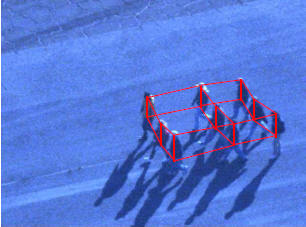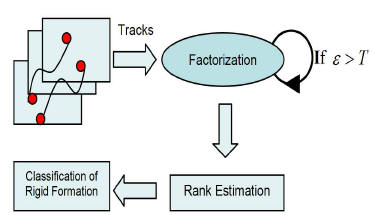Activity Recognition in Groups of People
Saad Masood Khan
In this project we developed a novel approach to recognize the class of activities characterized by their rigidity in formation for example people parades, airplane flight formations or herds of animals. The central idea is to model the entire group as a collective rather than focusing on each individual separately. We model the formation as a 3D polygon with each corner representing a participating entity (see figure 1). Tracks from the entities are treated as tracks of feature points on the 3D polygon. Based on the rank of the track matrix we can determine if the 3D polygon under consideration behaves rigidly or undergoes non-rigid deformation.


(a) (b)
Figure 1: (a) An example of a parade scene. The rigidity of the formation (the red polygon) characterizes the parade activity. (b) The diagram gives an outline of our proposed method for classification of rigidity in formation.
